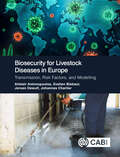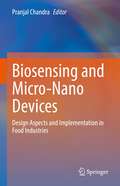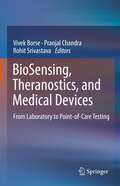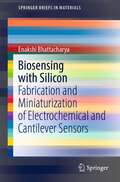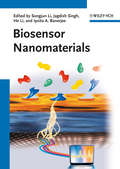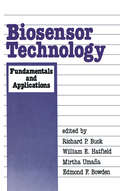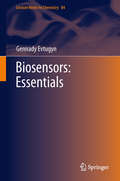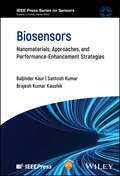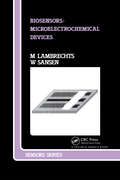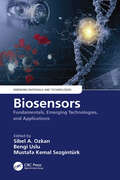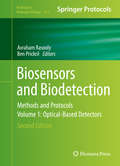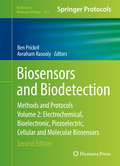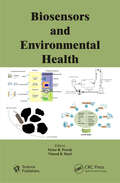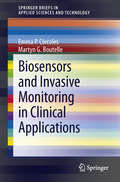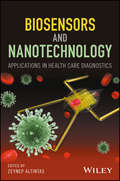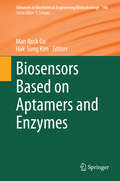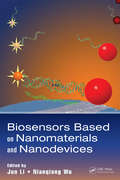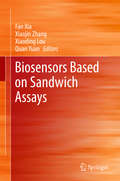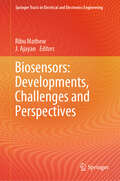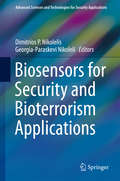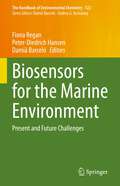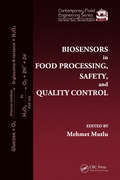- Table View
- List View
Biosecurity for Livestock Diseases in Europe: Transmission, Risk Factors, and Modelling
by Dr Alistair Antonopoulos Evelien Biebaut Jeroen Dewulf Johannes CharlierBiosecurity practices can help prevent the introduction and spread of disease, promoting better animal health and welfare, human health, food safety, and the economic benefits of livestock production. Stemming from a joint initiative between the Biosecure project which brought together 17 partners across 12 European countries, and DISCONTOOLS, the research gap database in animal health, this book provides valuable background information which can help to better understand and prioritize biosecurity measures. Driven by an evidence-based and cost-effective approach to biosecurity, it is divided into two sections covering endemic diseases typically present within most countries, and epidemic diseases with the potential for large scale outbreaks. Through a series of disease entries, it: - introduces the diseases of most relevance for the European context; - reviews our current understanding of biosecurity throughout the livestock production chain, and across the principal terrestrial animal species farmed within Europe: poultry, swine, cattle, and small ruminants; - covers the prevalence, risk factors, transmission routes, current control measures and biosecurity, and data for transmission modelling for each disease. By summarizing current knowledge on a range of diseases, this book forms both a useful resource for researchers and professionals in animal disease prevention, and a starting off point for identifying information gaps and requirements for future research.
Biosecurity in Animal Production and Veterinary Medicine: From principles to practice
by Jeroen Dewulf Filip Van ImmerseelGlobally, the way the animal production industry copes with infectious diseases is changing. The (excessive) use of antimicrobials is under debate and it is becoming standard practice to implement thorough biosecurity plans on farms to prevent the entry and spread of pathogenic micro-organisms. Not only in farm animal production, but also in facilities where companion animals are kept, including in veterinary practices and clinics, awareness of the beneficial implications of a good biosecurity plan has raised. The book Biosecurity in Animal Production and Veterinary Medicine is the first compilation of both fundamental aspects of biosecurity practices, and specific and practical information on the application of the biosecurity measures in different animal production and animal housing settings. The book starts with a general introductory chapter on the epidemiology of infectious diseases, followed by a chapter explaining the general principles of biosecurity. Specific topics of biosecurity, including rodent and insect control, cleaning and disinfection, hygiene and decontamination of feed, drinking water and air, and measuring the biosecurity status of farms, are detailed in dedicated chapters. Explanations on the relevance of the implementation of biosecurity plans in order to improve animal health and performance and reduce antimicrobial usage are described, and a chapter on ways to motivate farmers to implement a biosecurity plan has been included. Practical chapters deal with biosecurity in the poultry, pig and cattle industry, horse facilities, dog kennels, veterinary practices and clinics and laboratory animal facilities. The book is a practical guide that can be used by farm and animal facility managers, consultants, veterinarians, animal caretakers, and people with an interest in prevention of diseases in animals. Academics and students will benefit from the book because it contains all relevant information on animal biosecurity.
Biosensing and Micro-Nano Devices: Design Aspects and Implementation in Food Industries
by Pranjal ChandraThis book reviews applications of nanomaterial and nanodevices in the food industry. It also discusses the advanced bioanalytical techniques, including Enzyme-Linked Immunosorbent Assay (ELISA), immunoanalytical techniques, and monoclonal antibody-based immunological techniques for detecting food adulterations and allergens. It comprehensively covers electrode modification and nano-engineered fabrication of biosensors to enhance their functionalities for utilization in food industries. The book highlights the utilization of nanobiosensors for food safety and quality analysis, such as detection of toxin, food-borne pathogen, allergen, evaluation of toxicity etc. Further, it also summarizes the recent advances in nanodevices such as nano-systems, nano-emulsions, nanopesticides, and nanocapsules and their applications in the food industry. Lastly, it covers nanomaterial-based sensors for drug analysis in diverse matrices. It serves as an invaluable source of information for professionals, researchers, academicians, and students related to food science and technology.
BioSensing, Theranostics, and Medical Devices: From Laboratory to Point-of-Care Testing
by Vivek Borse Pranjal Chandra Rohit SrivastavaThis book provides up-to-date information on the prototypes used to develop medical devices and explains the principles of biosensing and theranostics. It also discusses the development of biosensor and application-orientated design of medical devices. In addition to summarizing the clinical validation of the developed techniques and devices and the regulatory steps involved in their commercialization, the book highlights the latest research and translational technologies toward the development of point-of-care devices in the health care. Lastly, it explores the current opportunities, challenges and provides troubleshooting on the use of biosensors in precision medicine. The book is helpful for researchers and medical professionals working in the field of clinical theranostics, and medical-device development wanting to gain a better understanding into the principles and processes involved in the development of biosensors.
Biosensing with Silicon: Fabrication and Miniaturization of Electrochemical and Cantilever Sensors (SpringerBriefs in Materials)
by Enakshi BhattacharyaThis book discusses two silicon biosensors: an electrochemical sensor – the Electrolyte Insulator Silicon Capacitor (EISCAP), and a mechanical resonant cantilever sensor. The author presents the principle and the technology behind the device fabrication and miniaturization, stable and reproducible functionalization protocols for bioreceptor immobilization, and the measurement and the data analysis for extracting the best performance from these sensors.EISCAP sensors, used for the estimation of triglycerides and urea, have been improved through the use of micromachining processes. The miniaturization brought out advantages as well as challenges which are discussed in this book, resulting in a prototype mini-EISCAP with a readout circuit for fast and accurate estimation of triglycerides. The author also reports on the sensitivity improvements in the estimation of triglycerides and urea obtained with the polycrystalline silicon cantilever and its measurements in liquid media.The book is ideal for materials scientists and engineers working in the field of biosensors and MicroElectroMechanical systems (MEMS) and their optimizations, as well as researchers with biochemical or biomedical expertise, in order to have a fresh and updated review on the last progresses reached with EISCAPs and cantilever sensors.
Biosensor Nanomaterials
by Songjun Li Jagdish Singh He Li Ipsita A. BanerjeeBiosensors are devices that detect the presence of microbials such as bacteria, viruses or a range biomolecules, including proteins, enzymes, DNA and RNA. For example, they are routinely applied for monitoring the glucose concentration in blood, quality analysis of fresh and waste water and for food control. Nanomaterials are ideal candidates for building sensor devces: where in just a few molecules can alter the properties so drastically that these changes may be easily detected by optical, electrical or chemical means. Recent advantages have radically increased the sensitivity of nanomaterial-based biosensors, making it possible to detect one particular molecule against a background of billions of others. Focusing on the materials suitable for biosensor applications, such as nanoparticles, quantum dots, meso- and nanoporous materials and nanotbues, this text enables the reader to prepare the respective nanomaterials for use in actual devices by appropriate functionalization, surface processing or directed self-assembly. The emphasis throughout is on electrochemical, optical and mechancial detection methods, leading to solutions for today's most challenging tasks. The result is a reference for researchers and developers, disseminating first-hand information on which nanomaterial is best suited to a particular application - and why.
Biosensor Technology: Fundamentals and Applications
by BuckThis authoritative reference covers recent advances in the field, stressing an interdisciplinaryapproach to the development and use of biosensor technology in physics,engineering, analytical chemistry, and biochemistry (including immunochemistry).about the editors ...RICHARD P. BucK is a Professor in the Chemistry Department, University of Northcarolina, Chapel Hill. Professor Buck serves on the editorial boards of severaljournals including Analytical Instrumentation: Applications and Designs for Chemica~Biomedica~ and Environmental Science (Marcel Dekker, Inc.). He is a member of theAmerican Chemical Society, Electrochemical Society, and International Society ofElectrochemistry. He received the B.S. (1950) and M.S. (1951) degrees from thecalifornia Institute of Tochnology, Pasadena, and Ph.D. degree (1954) from theMassachusetts Institute of Tochnology, cambridge.W1WAM E. HATFIELD is Mary Ann Smith Professor and Vice Chairman of Chemistry,and Acting Chairman of the Curriculum in Applied Sciences, University of Northcarolina, Chapel Hill. He is the author or coauthor of over 300 publications, andcoeditor, with John H. Miller, Jr., of High-Temperature Superconducting Materials:Preparations, Properties, and Processing (Marcel Dekker, Inc.). He is a member of theAmerican Chemical Society, American Association for the Advancement of Science,and Materials Research Society. He received the B.S. (1958) and M.S. (1959) degreesfrom Marshall University, Huntington, West Virginia, Ph.D. degree (1962) from theUniversity of Arizona, Tucson, and completed postdoctoral research at the Universityof Illinois, Urbana.M1KTHA UMANA is an independent consultant to Glaxo Inc. and Research 'IriangleInstitute, Research 'Iriangle Park, and Duke University Engineering Research Center,Durham, North carolina. The coauthor of numerous scientific journal articles, herresearch interests include surface chemistry, electrochemistry, and biosensors. Shereceived the B.Sc. degree (1969) from the University of Chile, Santiago, and Ph.D.degree (1972) from the University of London, England.EDMOND E BowoEN is an Associate Professor in the Department of Chemistry andin the Biotechnology Program, North carolina State University, Raleigh. Thecoauthor of numerous journal articles, his research interests include bioelectrochemistry,biological electron transfer, biosensors, and surface chemistry. He receivedthe B.S. degree (1970) from Syracuse University, Syracuse, New York, and Ph.D.degree (1982) from Virginia Commonwealth University, Richmond.
Biosensors: Theory and Applications
by Donald G. BuerkThis introductory text covers in detail the technology and applications of biosensors in their many forms. It provides an extensive survey of the basic principles, functions and applications of different categories of biosensors. The presentation is concise, systematic and well illustrated. Numerous schematics illustrate design and function.This bo
Biosensors: Essentials (Lecture Notes in Chemistry #84)
by Gennady EvtugynToday, biosensors are broadly applied in research, clinical diagnosis and monitoring, as well as in pharmaceutical, environmental or food analysis. In this work, the author presents the essentials that advanced students and researchers need to know in order to make full use of this technology. This includes a description of biochemical recognition elements, such as enzymes, antibodies, aptamers or even whole cells. Various signal transducers such as electrochemical and optical transducers, luminescence devices and advanced techniques such as quartz crystal microbalances and MEMS systems are covered as well. Current applications are introduced through various case studies, rounded out by a forward-looking chapter on the prospects for biosensor development offered by nanotechnology, lab-on-a-chip, and biomimetic systems.
Biosensors: Nanomaterials, Approaches, and Performance-Enhancement Strategies (IEEE Press Series on Sensors)
by Baljinder Kaur Santosh Kumar Brajesh Kumar KaushikComprehensive resource covering new technologies, materials, strategies, and recent advancements in the field of biosensing Biosensors summarizes cutting-edge technologies in biosensing, including gene editing (known as Clustered Regularly Interspaced Short Palindromic Repeat or CRISPR), quorum sensing utilizing inter and intra cell signals, two-dimensional (2D) materials and aptamer-mediated sensor designs, and more, with additional coverage of the latest materials, strategies, and advancements made in the field. Chapters are categorized on the basis of various bio-recognition elements that include aptamer, nucleic acid, enzymes, antibodies, bacteriophages, peptides, and molecular imprinted polymers. Plasmonic, surface-enhanced Raman scattering, colorimetric, fluorescence, electrochemical, magneto and piezo-electric biosensor sensing techniques are also considered. The roles of various nanomaterials, advancement in synthesis, signal enhancement strategies, and new trends for biomedical applications are also described. Current challenges, limitations, and future prospects to developing biosensors for point-of-care and clinical applications are also discussed. Written by three highly qualified authors, Biosensors includes information on: Diverse bio-receptors include nucleic acids, aptamers, enzymes, antibodies, bacteriophages, molecularly imprinted polymers, whole-cell, and techniques of immobilization Different transduction principles using bio-receptors (e.g., optical, electrochemical, piezo-electrical, and SERS) to detect microorganism, toxins, and diseases Nanomaterials synthesis, their role in biosensing, pros and cons of carbon, polymer, metals, metal oxides, and quantum dots-based nanomaterials in medical biosensing applications Biosensors is a comprehensive and complete resource on the subject for researchers and professionals in physics, chemistry, and biomedical science, research communities working in the fields of plasmonics, optics, biosensors, and nano-photonics, and students in related programs of study.
Biosensors: Microelectrochemical Devices
by M Lambrechts W SansenBiosensors are analytical devices that combine a biologically sensitive element with a physical or chemical transducer to selectively and quantitatively detect the presence of specific compounds. Balancing basics, principles, and case studies, Biosensors: Microelectrochemical Devices covers the theory and applications of one class of biosensor-microelectrochemical devices. The book clearly explains microelectronic techniques used to produce these cheap, fast reacting, and disposable sensors with the aid of helpful diagrams and tables. Researchers and postgraduates active in the field of chemical sensors, analytical chemistry, or microelectronics will find this an invaluable reference.
Biosensors: Fundamentals, Emerging Technologies, and Applications (Emerging Materials and Technologies)
by Sibel A. Ozkan Bengi Uslu Mustafa Kemal SezgintürkBiosensors: Fundamentals, Emerging Technologies, and Applications provides insight into the sensing applications of different types of biosensors relating to environmental pollutants, microbiological analysis, and healthcare. It describes state-of-the-art research in biosensors, point of care testing, potential applications, as well as future prospects for biosensors. This book: Presents the essentials that readers need to know to make full use of biosensor technology Discusses recent perspectives on optical and electrochemical biosensors Details biosensor types for medical applications Teaches how to use enzymes for biological recognition in biomarker assays Proposes innovations in wearable and smart biosensors This book is aimed at advanced students, researchers, and academics across a broad interdisciplinary field including biochemical, pharmaceutical, and environmental engineering as well as materials science, analytical chemistry, and biosciences.
Biosensors and Biodetection: Methods and Protocols Volume 1: Optical-Based Detectors (Methods in Molecular Biology #1571)
by Avraham Rasooly Ben PrickrilThis volume provides comprehensive and detailed technical protocols on current biosensor and biodetection technologies and examples of their applications and capabilities. Chapters in Biosensors and Biodetection: Methods and Protocols, Volume 1: Optical-Based Detectors, Second Edition chapters focus on direct and indirect optical detectors including surface plasmon resonance, interferometric sensors, charge-coupled device (CCD) based detectors, spectrometry, and many other cutting-edge optical biosensors technologies. Written in the format of the highly successful Methods in Molecular Biology series, chapters include introductions to their respective topics, lists of the necessary materials and reagents, tips on troubleshooting and avoiding known pitfalls, and step-by-step, readily reproducible laboratory protocols. Authoritative and practical, Biosensors and Biodetection: Methods and Protocols, Volume 1: Optical-Based Detectors, Second Edition offers descriptions of major technologies by leading experts in the field in extensive technical detail. The aim of the book is to make biosensors more accessible and understandable to engineers, students, medical professionals, molecular biologists, chemical, and physical science researchers developing biosensor technologies, allowing readers to both understand the technology and to construct similar devices.
Biosensors and Biodetection: Methods and Protocols, Volume 2: Electrochemical, Bioelectronic, Piezoelectric, Cellular and Molecular Biosensors (Methods in Molecular Biology #1572)
by Avraham Rasooly Ben PrickrilThis volume provides comprehensive and detailed technical protocols on current biosensor and biodetection technologies and examples of their applications and capabilities. Chapters in Biosensors and Biodetection: Methods and Protocols, Volume 1: Optical-Based Detectors, Second Edition chapters focus on direct and indirect optical detectors including surface plasmon resonance, interferometric sensors, charge-coupled device (CCD) based detectors, spectrometry, and many other cutting-edge optical biosensors technologies. Written in the format of the highly successful Methods in Molecular Biology series, chapters include introductions to their respective topics, lists of the necessary materials and reagents, tips on troubleshooting and avoiding known pitfalls, and step-by-step, readily reproducible laboratory protocols. Authoritative and practical, Biosensors and Biodetection: Methods and Protocols, Volume 1: Optical-Based Detectors, Second Edition offers descriptions of major technologies by leading experts in the field in extensive technical detail. The aim of the book is to make biosensors more accessible and understandable to engineers, students, medical professionals, molecular biologists, chemical, and physical science researchers developing biosensor technologies, allowing readers to both understand the technology and to construct similar devices.
Biosensors and Environmental Health
by Victor R. Preedy Vinood B. PatelDiscussing the role biosensors play in detecting and monitoring environmental substances, Biosensors and Environmental Health provides key facts that can be applied to other areas of health and disease and a "mini-dictionary" of key terms and summary points. It covers personal toxicity testing, soil and risk assessment, pesticide, insecticides, par
Biosensors and Invasive Monitoring in Clinical Applications (SpringerBriefs in Applied Sciences and Technology)
by Martyn G. Boutelle Emma P. CórcolesThis volume examines the advances of invasive monitoring by means of biosensors and microdialysis. Physical and physiological parameters are commonly monitored in clinical settings using invasive techniques due to their positive outcome in patients' diagnosis and treatment. Biochemical parameters, however, still rely on off-line measurements and require large pieces of equipment. Biosensing and sampling devices present excellent capabilities for their use in continuous monitoring of patients' biochemical parameters. However, certain issues remain to be solved in order to ensure a more widespread use of these techniques in today's medical practices.
Biosensors and Nanotechnology: Applications in Health Care Diagnostics
by Zeynep AltintasProvides a broad range of information from basic principles to advanced applications of biosensors and nanomaterials in health care diagnostics This book utilizes a multidisciplinary approach to provide a wide range of information on biosensors and the impact of nanotechnology on the development of biosensors for health care. It offers a solid background on biosensors, recognition receptors, biomarkers, and disease diagnostics. An overview of biosensor-based health care applications is addressed. Nanomaterial applications in biosensors and diagnostics are included, covering the application of nanoparticles, magnetic nanomaterials, quantum dots, carbon nanotubes, graphene, and molecularly imprinted nanostructures. The topic of organ-specific health care systems utilizing biosensors is also incorporated to provide deep insight into the very recent advances in disease diagnostics. Biosensors and Nanotechnology: Applications in Health Care Diagnostics is comprised of 15 chapters that are presented in four sections and written by 33 researchers who are actively working in Germany, the United Kingdom, Italy, Turkey, Denmark, Finland, Romania, Malaysia and Brazil. It covers biomarkers in healthcare; microfluidics in medical diagnostics; SPR-based biosensor techniques; piezoelectric-based biosensor technologies; MEMS-based cell counting methods; lab-on-chip platforms; optical applications for cancer cases; and more. Discusses the latest technology and advances in the field of biosensors and their applications for healthcare diagnostics Particular focus on biosensors for cancer Summarizes research of the last 30 years, relating it to state-of-the-art technologies Biosensors and Nanotechnology: Applications in Health Care Diagnostics is an excellent book for researchers, scientists, regulators, consultants, and engineers in the field, as well as for graduate students studying the subject.
Biosensors Based on Aptamers and Enzymes (Advances in Biochemical Engineering/Biotechnology #140)
by Man Bock Gu Hak-Sung KimVolumes are organized topically and provide a comprehensive discussion of developments in the respective field over the past 3-5 years. The series also discusses new discoveries and applications. Special volumes are dedicated to selected topics which focus on new biotechnological products and new processes for their synthesis and purification. In general, special volumes are edited by well-known guest editors. The series editor and publisher will however always be pleased to receive suggestions and supplementary information. Manuscripts are accepted in English.
Biosensors Based on Nanomaterials and Nanodevices (Nanomaterials and their Applications)
by AntonioBiosensors Based on Nanomaterials and Nanodevices links interdisciplinary research from leading experts to provide graduate students, academics, researchers, and industry professionals alike with a comprehensive source for key advancements and future trends in nanostructured biosensor development. It describes the concepts, principles, materials, device fabrications, functions, system integrations, and applications of various types of biosensors based on signal transduction mechanisms, including fluorescence, photonic crystal, surface-enhanced Raman scattering, electrochemistry, electro-luminescence, field-effect transistor, and magnetic effect. The book: Explains how to utilize the unique properties of nanomaterials to construct nanostructured biosensors to achieve enhanced performance Features examples of biosensors based on both typical and emerging nanomaterials, such as gold nanoparticles, quantum dots, graphene, graphene oxides, magnetic nanoparticles, carbon nanotubes, inorganic nanowires/nanorods, plasmonic nanostructures, and photonic crystals Demonstrates the broad applications of nanostructured biosensors in environmental monitoring, food safety, industrial quality assurance, and in vitro and in vivo health diagnosis Inspires new ideas for tackling multiscale and multidisciplinary issues in developing high-performance biosensors for complex practical biomedical problems Focusing on the connection between nanomaterials research and biosensor development, Biosensors Based on Nanomaterials and Nanodevices illustrates the exciting possibilities and critical challenges of biosensors based on nanomaterials and nanodevices for future health monitoring, disease diagnosis, therapeutic treatments, and beyond.
Biosensors Based on Sandwich Assays
by Fan Xia Xiaojin Zhang Xiaoding Lou Quan YuanThis book shows the various sandwich assays that are constructed from recognition molecules, such as antibodies, oligonucleotide sequences and aptamers, developed as a result of nano- and biotechnology advances. It consists of ten chapters presenting interesting examples of these assays, organized according to the type of analytic methods (colorimetric, fluorescence, electrochemical, etc. ) and detected objects (protein, nucleic acid, small-molecule, ion, etc. ). It also includes a chapter discussing the introduction of sandwich assays as biosensors for the detection of a range of targets. It is an interesting and useful resource for a wide readership in various fields of chemical science and nanotechnology.
Biosensors: Developments, Challenges and Perspectives (Springer Tracts in Electrical and Electronics Engineering)
by J. Ajayan Ribu MathewThis book equips its readers with fundamental concepts and a comprehensive understanding of the principle and functionality of biosensors. This book focuses on various biosensor technologies like field effect transistor (FET), plasmonics, bioresorbable biosensors, electro-chemical biosensors, etc., and their applications. The book also covers the reliability aspects and challenges in biosensor development that are a major cause of erroneous calibration and even failure. The book also features the concept of bio receptors, immobilization techniques, target-receptor interactions, surface energy changes, sensitivity, selectivity, etc. This would be an ideal reference for researchers and scholars studying biosensors realized with various material sets and technologies including state-of-the-art modern materials and innovative techniques.
Biosensors for Security and Bioterrorism Applications (Advanced Sciences and Technologies for Security Applications)
by Dimitrios P. Nikolelis Georgia-Paraskevi NikoleliThis book offers comprehensive coverage of biomarker/biosensor interactions for the rapid detection of weapons of bioterrorism, as well as current research trends and future developments and applications. It will be useful to researchers in this field who are interested in new developments in the early detection of such. The authors have collected very valuable and, in some aspects indispensable experience in the area i. e. in the development and application of portable biosensors for the detection of potential hazards. Most efforts are centered on the development of immunochemical assays including flow-lateral systems and engineered antibodies and their fragments. In addition, new approaches to the detection of enzyme inhibitors, direct enzymatic and microbial detection of metabolites and nutrients are elaborated. Some realized prototypes and concept devices applicable for the further use as a basis for the cooperation programs are also discussed. There is a particular focus on electrochemical and optical detection systems, including those employing carbon nanotubes, quantum dots and metal nanoparticles. The authors are well-known scientists and most of them are editors of respected international scientific journals. Although recently developed biosensors utilize known principles, the biosensing devices described can significantly shorten the time required for successful detection and enhance efforts in more time-consuming directions, e. g. remote sensing systems and validation in real-sample analysis. The authors describe advances in all stages of biosensor development: the selection of biochemical components, their use in biosensor assembly, detection principles and improvements and applications for real sample assays.
Biosensors for the Marine Environment: Present and Future Challenges (The Handbook of Environmental Chemistry #122)
by Fiona Regan Peter-Diedrich Hansen Damià BarcelóThis book is devoted to the exploration of innovative sensing technologies for marine applications. The book focuses on various novel biosensor designs from nano-biosensors to molecularly imprinted polymers offering a broad perspective for marine biosensors development to deployment challenges.The book aims to target researchers in the area of marine monitoring, sensor developments and deployment of devices in the marine environment.
Biosensors in Agriculture: Recent Trends and Future Perspectives (Concepts and Strategies in Plant Sciences)
by Ramesh Namdeo Pudake Utkarsh Jain Chittaranjan KoleThis book reviews the application of nanosensors in food and agriculture. Nanotechnology has the potential to become transformative technology that will impact almost all sectors. Tools like nanosensors, which detect specific molecular interactions, can be used for on-site, in-situ and online measurements of various parameters in clinical diagnostics, environmental and food monitoring, and quality control.Due to their unprecedented performance and sensitivity, nanobiosensors are gaining importance in precision farming. The book examines the use of nanobiosensors in the monitoring of food additives, toxins and mycotoxins, microbial contamination, food allergens, nutritional constituents, pesticides, environmental parameters, plant diseases and genetically modified organisms. It also discusses the role of biosensors in increasing crop productivity in sustainable agriculture, and nanosensor-based smart delivery systems to optimize the use of natural resources such as water, nutrients and agrochemicals in precision farming.
Biosensors in Food Processing, Safety, and Quality Control (Contemporary Food Engineering)
by Mehmet MutluThis book details the latest developments in sensing technology and its applications in the food industry, profiling the improvements achieved in recent years for better food quality, safety, processing, and control. Topics discussed include the use of biosensors for the assessment of natural toxins in food and for pesticides and foodborne pathogen
